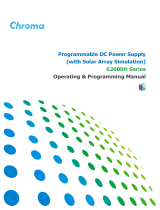Page is loading ...

SIM-9106/9303
High Current Switching Mode Power Supply with C.C., C.V., Remote Control & Sensing
User Manual
1. INTRODUCTION
This family of high power remote sensing, remote control, switching mode CC\CV power supply offers
unique solution for various loading conditions and applicances.
The remote control functionality makes :
1. output power on/off possible without turning the power on/of switch of the unit
2. adjusting the output voltage and current without turning the control of the unit.
The remote sensing capablility is important for load away from the power supply or when load current
becomes erratic.
It is ideal for applications that require precise voltage at the point of regulation.
When using it as a normal power supply, the 10-turn potentiometers provide precise output voltage and
current control. The 4 digit LED meters will clear indication of automatic cross over of CC and CV mode
provide easy read outs.
It is suitable for a wide range of applications such as production testing, laboaratory, field test of voltage
critical distant load, telecommunication, powering of dc network and etc...
2. PRECAUTIONS
● Never Short the Remote Sensing Terminal
● Never use the same ground for voltage remote control and current remote control
●This power supply is for Indoor Use Only.
● Do not expose the power supply to sun, high humid and dusty environment.
●Never remove the metal cover of the power supply while AC power is connected.
●Never touch the unit when your hands are wet.
●Never block the ventilation slots and cooling fan air intake window
●Never attempt to repair the power supply. Incorrect re-assembly may result in a risk of electric shock or
fire.
●Never use the power supply for the load requiring higher current than the designed value
otherwise it may damage the power supply.
●Place the power supply on a flat surface with sufficient clearance, dry, dust free surroundings for
ventilation.
3. CONTROLS AND INDICATORS
(1) Voltage & Ammeter LED Display with CC\CV Indictor
(2) Output Voltage Control Knob
(3) Output Current Control Knob
(4) Power ON/OFF Switch
(5) Output Terminal (Rated 60A for SIM-9106 / Rated 30A for SIM-9303)
CAUTION! : The AC Input is DOUBLE POLE FUSING
Rear
Front

(6) Remote Sensing Terminal (Warning! : Never short the remote sensing terminal, Never connect the
Remote Sensing Terminal in reverse polarity)
(7) Voltage Remote Control ON/OFF Switch
(8) Current Remote Control ON/OFF Switch
(9) Remote Control Terminal
(10) Cooling Fan Air Intake Grille
(11) AC Input Plug
4. CONNECTION
4.1 This series has 2 models. Make sure you have purchased the correct one.
They have different output voltage range and current as following:
Model Number Output Voltage Range Total Rated Current
SIM - 9106 1 ~ 15V 60A
SIM - 9303 1 ~ 30V 30A
4.2 Check the rating label of the power supply and make sure it complies with your AC mains voltage.
Connect the power supply to the AC Mains using the provided power cord.
Steps 4.3 & 4.4 explain how to use the special features: remote sensing and remote control.
You can use the 2 features at the same time or separately.
Please go to step 4.5 if you do not use the 2 features and make sure both voltage and current
remote control ON/OFF switches are in OFF position(rear panel).
4.3 If you do not use the remote control feature, make sure both voltage and current remote control
ON/OFF switch is in OFF position(Rear panel).
4.4 Switch on the power supply and the power ON/OFF LED should light up in green.
Then, adjust the output voltage to the desired voltage and switch off the power supply.
4.5 Connect the equipment to the power supply. Red (+) is connected to the positive polarity input of the
equipment and Black (-) is connected to the negative polarity input of the equipment.
4.6 Switch on the power supply first and the LED Indicator should light up in green.
4.7 Switch on the equipment and the LED Indicator should still remain in green.
4.8 You can now operate the equipment.
When an operation is finished, switch off the equipment first and then switch off the power supply.
4.9 When disconnecting the power supply from the unit, disconnect the remote sensing wire first, then
disconnect the output cables.
5. REMOTE SENSING – Take note of the warning and follow the order of installation.
Warning!:Never short the Remote Sensing Terminal
Connection:
1. First complete the power connections between power supply and equipment.
2. Check and make sure the power connections are secure.
3. Then make connections between Remote Sensing and equipment.
Warning!:Never short the Remote Sensing Terminal
Never connect the Remote Sensing Terminal in reverse polarity
Fig 3 showing connections between Remote Sensing, Power output and Equipment.

The remote sensing wire should be AT LEAST 22AWG wire size.
Dis-connection:
1. First disconnect the remote sensing connections.
2. Then disconnect the power connections between the power supply and equipment.
6. REMOTE CONTROL
You can use the voltage and current remote control at the same time or separately.
Warning!: The voltage remote control and current remote control must NOT common ground.
6.1 VOLTAGE REMOTE CONTROL
Set up the provided remote connector plug
(a) Remove the black portion of the remote control connector plug by removing the screw as Fig 4.
1. Remove the screw 2. Rotate the black portion
(b) Solder 3 wires(22AWG) to PORT 1, 2 & 3 of black portion as shown in Fig.5.
(c) Make sure the load is disconnected and the power supply is OFF.
(d) Plug the remote connector plug into the remote control terminal of the power supply.
(e) Secure the remote connector plug to the terminal socket by locking connector ring(Fig 6).
Black portion
Silver portion Fig. 4
Outer ring
Fig. 6
Fig. 5
Port numbers are marked on the
black portion

Then, you can choose either method A or B below to use the remote control feature:
Method A : Using Voltage Source
A variable external voltage source of 0 ~ 5V is fed into the remote control terminal to
adjust the output voltage level.
Warning! : Do not input higher than 5V, otherwise the OverVoltage Protection(OVP) will be
triggered.
A (i) Make sure the load is disconnected and the power supply is OFF.
(ii) Use ONLY wires from port 2 and 3. Then, connect port 2 to positive polarity of the external
voltage source and port 3 to negative polarity of the external voltage source.
(iii) Turn the Voltage Remote Control ON/OFF Switch to ON position.
(iv) Switch on the power supply.
(v) Vary the external input voltage 0 – 5V to check and verify for the full output voltage range
of power supply.
(vi) Switch off the power supply.
Method B: Using 5kohm Variable Resistor
B (i) Make sure the load is disconnected and the power supply is OFF.
(ii) Prepare a 5kohm variable resistor and use wires from port 1, 2 and 3 as shown in Fig.7.
(iii) Turn the the Remote Control ON/OFF Switch to ON position.
(iv) Switch on the power supply.
(v) Adjust the 5kohm variable resistor from one end to other end to check and verify for the full
output voltage range of power supply.
(vi) Switch off the power supply.
6.2 CURRENT
REMOTE CONTROL
(a) Using the same connector plug in section 4.4.1.
Remove the black portion of the remote control connector plug by removing the screw as Fig 8.
1. Remove the screw 2. Rotate the black portion
To Port 1
To Port 2
To Port 3
Fig. 8
Black portion
Silver portion

(b) Solder 3 wires(22AWG) to PORT 4, 5 & 6 of black portion as shown in Fig.9.
(c) Make sure the load is disconnected and the power supply is OFF.
(d) Plug the remote connector plug into the remote control terminal of the power supply.
(e) Secure the remote connector plug to the terminal socket by locking connector ring(Fig 10).
Then, you can choose either method A or B below to use the remote control feature:
Method A : Using Voltage Source
A variable external voltage source of 0 ~ 2.5V is fed into the remote control terminal to
adjust the constant current level.
Warning! : Do not input higher than 2.5V, otherwise it may damage the unit.
A (i) Make sure the load is disconnected and the power supply is OFF.
(ii) Use ONLY wires from port 5 and 6. Then, connect port 5 to positive polarity of the external
voltage source and port 6 to negative polarity of the external voltage source.
(iii) Turn the Current Remote Control ON/OFF Switch to ON position.
(iv) Use a 8AWG Wire to short circuit the main output terminal in the rear panel.
(v) Switch on the power supply.
(vi) Vary the external input voltage 0 – 2.5V to check and verify for the full output current range
of power supply.
(vii) Switch off the power supply and disconnect the 8AWG Wire.
Method B: Using 0-5kohm Variable Resistor
B(i)Make sure the load is disconnected and the power supply is OFF.
(ii) Prepare a 5kohm variable resistor and use wires from port 4, 5 and 6 as shown in Fig. 11.
(iii) Turn the the Remote Control ON/OFF Switch to ON position.
(iv) Use a 8AWG Wire to short circuit the main output terminal in the rear panel.
(v) Switch on the power supply.
(vi) Adjust the 5kohm variable resistor from one end to other end to check and verify for the full
output current range of power supply.
(vii) Switch off the power supply and disconnect the 8AWG Wire.
Outer ring
Fig. 10
Fig. 9
Port numbers are marked on the
black portion
To Port 4
To Port 5
To Port 6
Fig. 11

6.3 ENABLE AND DISABLE THE OUTPUT
You can use Port 7 and 8 to remote control the OUTPUT ON/OFF.
a) Open Port 7 and 8 if you want to ENABLE the output ( by default ).
b) Short Port 7 and 8 if you want to DISABLE the output.
7. SPECIFICATIONS
SIM-9106 SIM-9303
Variable Output Voltage 1 ~ 15V 1 ~ 30V
Total Rated Output Current 1 ~ 60A 1 ~ 30A
Rated Output Current (Main) 1 ~ 60A 1 ~ 30A
Ripple and Noise 50mVp-p
Load Voltage Regulation( 0-100% sense ) 0.1% + 5mV
Load Voltage Regulation( 0-100% no sense ) 0.1% + 5mV
Line Voltage Regulation 0.05% + 3mV
Line Current Regulation 0.1% + 5mA
Load Current Regulation 0.2% + 5mA
Input Voltage 100 – 240 VAC
Efficiency >82%
Dynamic Power Factor Correction >0.97 at optimal load
Voltmeter and Ammeter Display 4 digit LED display
Meter Accurancy ±1% + 1 count
Indicator Constant Voltage (C.V.) and Constant Current(C.C.) Indicator
Special Feature Remote Control & Remote Sensing
Cooling Method Variable Speed thermal static control fan
Operating Temperature 0 ~ 40 °C
Protections Overload(Constant Current Limiting), Short Circuit,
Overtemperature and OVP
Input Fuse 20A (T20AL250V)
Approvals CE-EMC: EN 55011 CE-LVD:EN 61010
Dimension 235 (W) x (H)95 x 355(D) mm
Weight 5.8Kg
Rev.2 11/2008
7673-9106-0002
/


